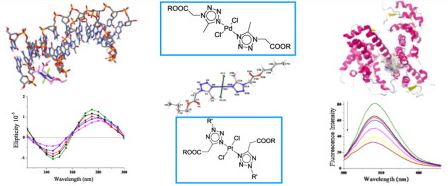A. V.Protas, E.A.Popova, O. V.Mikolaichuk, Y. B.Porozov, A. R.Mehtiev, I. Ott, G. V. Alekseev, N. A.Kasyanenko, R. E.Trifonov
“Synthesis, DNA and BSA binding of Pd(II) and Pt(II) complexes featuring tetrazolylacetic acids and their esters”
Inorganica Chimica Acta, 2018, 473, 133-144
DOI:10.1016/j.ica.2017.12.040
Two series of palladium(II) and platinum(II) complexes featuring esters of tetrazol-1-yl and tetrazol-5-ylacetic acids {trans-[PdCl2L2] and trans-[PtCl2L2], L = 5-methyl-1H-tetrazol-1-ylacetic acid and its ethyl, butyl, isobutyl esters (1–5); 2-R-2H-tetrazol-5-ylacetic acid and its ethyl esters, R = tBu, CH2CH2OH (6–10)} were synthesized and their binding to calf-thymus DNA (CT DNA) and bovine serum albumin (BSA) were studied by means of experimental (CD, UV, viscometry, fluorometric and electrophoretic techniques) and theoretical methods. According to the spectrophotometric data, the interaction of the metal complexes with CT DNA is observed. The significant increase of melting point of CT DNA in the presence of the metal complexes (ΔTm = 8–13 °C) indicates strong stabilization of the DNA helix. Electrophoretic studies demonstrate the ability of the metal complexes to interact with pBR322 plasmid DNA and to change its mobility. According to the data of the fluorescence quenching technique, binding with constants (Kbin) of Pd(II) complexes with BSA are in the range 0.83–4.12 × 105 L M−1. The molecular docking studies show the minor groove binding behavior of tetrazole-containing palladium(II) and platinum(II) complexes to DNA (ΔGbinding. −5.56 − −6.12 kcal/mol) and effective binding to BSA via the favored binding site Trp213 (ΔGbinding −7.2 − −7.56 kcal/mol). The complex trans-[PtCl2(2-tert-butyl-tetrazol-5-ylacetic acid)2] exhibited noticeable antiproliferative activity in two human cancer cell lines with IC50 values of 11.40 µM in HT-29 cells and 11.02 µM in MDA-MB-231 cell line.
